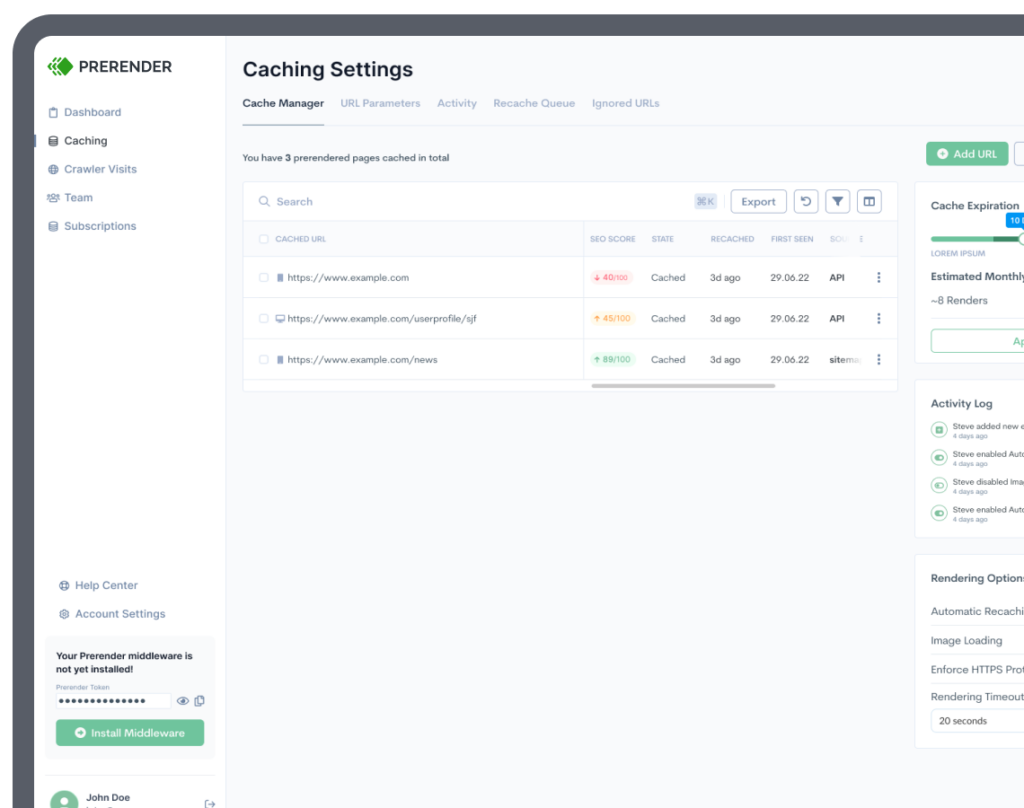Around 98.7% of websites are made with JavaScript.
This number isn’t shocking, as JavaScript can elevate the user experience by adding animation and interactivity to websites. That said, JavaScript isn’t SEO-friendly, and server-side rendering (SSR) is created to fix this issue. Unfortunately, SSR isn’t perfect either. As it fixes the JavaScript SEO problem, it compromises other crucial parts of technical SEO—which can influence the SERP rankings.
What is SSR, what are the advantages and disadvantages of using SSR, and are there alternatives to it? All of these questions will be answered in this blog.
What is Server-Side Rendering (SSR)?
Server-side rendering (SSR) is a method of loading your website’s JavaScript onto your own server—hence the name server-side rendering.
To understand more about SSR, first, you need to know how Google crawling and indexing work.
Google indexes JavaScript-based web pages using a two-wave indexing system. First, Googlebot crawls your pages and extracts all their HTML, CSS, and links. This typically finishes within a few hours. Googlebot will leave the JavaScript files untouched, queueing them for the rendering process (the second step).
Depending on your crawl budget availability, this can take several hours to weeks. During that time, your web pages are not being indexed and, therefore, not being found on Google. That’s a lot of traffic you’re missing out on.
What’s worse, if your JavaScript pages aren’t able to be crawled and indexed perfectly, Google reads them as a blank screen and ranks them accordingly, which can hurt your website’s SEO health.
Google has claimed that Googlebot is able to crawl and index Javascript-based web pages just fine, but this has yet to be proven. Other search engines, such as Bing, Yandex, and DuckDuckGo, cannot crawl JavaScript at all.
Now, how can SSR solve this?
How Does SSR Impact SEO Performance?
The problem with JavaScript crawling and indexing is that it needs additional processing power compared to indexing static HTML content, thereby eating up more of your website’s allocated crawl budget.
SSR is designed to solve this problem. It renders JavaScript on your own servers rather than putting the burden on the user agent, making the content fast and easily accessible when requested, both by search engine crawlers and human users.
As a result, here’s what SSR can do to your SEO health:
- flawlessly crawled and indexed JavaScript pages
- no wasted crawl budgets or plummeting search rankings
- no sluggish two-wave indexing process; just smooth, seamless indexation and the steady stream of Google traffic that comes with it
However, as mentioned, SSR isn’t a perfect solution either.
Disadvantages of Server-Side Rendering (SSR)
One of the biggest disadvantages of adopting SSR is that SSR puts the burden of rendering your JavaScript content on your own servers, which will rack up your server maintenance costs.
Websites that use JavaScript frameworks need universal libraries to enable SSR; Angular requires Angular Universal, React, and Vue need Next.JS. All of them require additional work from your engineering team, which costs you money.
Moreover, SSR pages will have a higher TTFB latency and a slower time-to-interactive. Your users will see the content sooner, but if they click on something, nothing will happen. They can get frustrated and leave.
Therefore, SSR is not a fix-all solution. It’s expensive, difficult to implement, and requires a lot of manpower to set up. You need to assess your website’s technical needs and challenges before implementing it.
Advantages of Server-Side Rendering (SSR)
Besides helping websites solve indexing and JavaScript SEO problems, SSR has other benefits.
SSR also optimizes web pages for social platforms, not just search engines. When someone shares your page on Facebook or LinkedIn, the post includes a preview of the page.
Pro tip: Learn more about Open Graph meta tags—a smart solution to display the rich snippet of your content on social media.
Additionally, SSR comes with a number of performance benefits that improve your website’s UX. SSR pages have better largest contentful paint (LCP) (how quickly the main content of a web page loads and is visible to users) and cumulative layout shift (CLS) (how much the elements on a webpage move around during the loading process). These are two of the three elements of Core Web Vitals—a ranking factor.
Generally, Google gives preferential search rankings to sites with fast page load speed. Faster load times improve user metrics such as session duration and bounce rate; Google algorithms look at these metrics and give you an extra SEO boost.
In short, faster web pages equals happy search engines and happy users.
Prerendering: An Alternative to SSR in Making JavaScript SEO-Friendly
SSR has a lot of benefits that compensate for the technical deficiencies and deteriorated user experience of CSR. However, it has its own limitations and expensive costs, which may not be the best solution for your website.
Another alternative to SSR is prerendering, such as with Prerender. Prerender fetches all your page’s resources ahead of time and stores a cached version for search engines. This will cut down on the indexing time and improve the indexing success rate.
As a plug-and-play solution, you only need to install the middleware that matches your programming language, and you can instantly enjoy Prerender. Furthermore, there’s no upfront cost, and can easily scaled depending on your needs.
Here is an extensive comparison of prerendering (Prerender) and SSR:
Bonus: What is The Difference Between SSR and CSR?
Client-side rendering (CSR) is another method to solve the JavaScript-SEO roadblock.
Unlike server-side rendering, client-side rendering loads a website’s JavaScript in the user’s browser, not the website’s server. Furthermore, CSR defaults to websites built with front-end JavaScript frameworks such as Angular, React, or Vue.
In general, here are some other differences between SSR and CSR:
- Performance
- SSR: Offers faster initial page load times, but slower interaction once loaded
- CSR: Offers slower initial page load times, but faster interaction once loaded
- Effects on SEO
- SSR: Better for SEO
- CSR: Less SEO-friendly than SSR
- Caching implementation
- SSR: easy to implement
- CSR: more difficult to implement
- Initial investment
- SSR: high up-front investment
- CSR: low up-front investment
Improve Your SEO With Prerender
SSR may make JavaScript and SEO work together, but it isn’t the fix-all solution. It comes with high upfront and maintenance costs, as well as some flaws in the technical SEO elements.
If you’re looking for an alternative to SSR, consider prerendering with Prerender. We turn dynamic JavaScript content into static HTML, allowing bots to index every content element quickly and perfectly.
Prerender is trusted by 65,000+ businesses worldwide, including Walmart, Salesforce, and more. Sign up today and enjoy 1,000 free renders.




